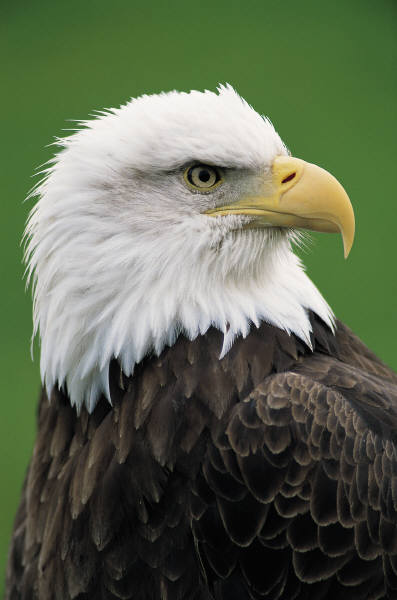
Eagle's Eye Sight
One enormously important adaptation eagles have obtained for hunting is their eye sight. Compared to a humanís eye sight, an eagleís is roughly four times the strength. But the efficiency of their vision is not the only aspect which increases their hunting prowess. The eagleís eye has two foveae, or centers of focus. Because the eagleís eyes are located more laterally than humans, this allows them to see nearly 270 degrees around the head.
| In this diagram, the pink represents the field of vision seen by one eye, and the overlapping red area represents binocular vision seen by both eyes. As you can see, the field of vision of the eagle is much larger than that of humans. |
|
The eagle
eye is very large (about the size of a humans on their comparatively small
body), and fits tightly into the eye socket. This makes it difficult to move the
eye to change the field of view. To compensate for this, an eagle can rotate its
head easily on its flexible neck, much like an owl. However, unlike the
nocturnal owl, an eagle is diurnal or active during the day. Because form
follows function, this means the internal structure of the eye is much
different.
There are two types of light receptors in the eye: rods and cones.
- Rods are very light sensitive and cannot distinguish color, but give info on the intensity of light.
- Cones are only activated in bright light, and can distinguish different colors.
Because of
their relative inactivity during times of low light, cones have dominated areas
of the eye which correlates with the heightened vision of the eagle. Increasing
the number of cones in turn decreases the number of rods, which explains the
eagle not being a nocturnal bird.
Another interesting fact about eagleís eyes, which is
probably related to their high levels of awareness during the day is an inner
eyelid called the nictitating membrane. This eyelid is separate from another
eyelid which closes during sleep. It blinks to wipe away dust and restore
moisture, but is transparent as to not disrupt vision.
Talons
Contrary to what you make think, Eagles primary mechanism for killing their prey is their razor sharp talons, and not their beak. The talons of the bald eagle, as well all the other fish eagles, is specialized for the capture of fish by means of rough spicules which aid in capturing the slippery fish. Also, the feet of bald eagles have a stronger grip strength because they are also known to capture small mammals and other birds.
